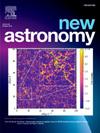两个接触wuma型接触双星V551 Dra和CN Hyi的轨道周期研究
IF 2.1
4区 物理与天体物理
Q2 ASTRONOMY & ASTROPHYSICS
引用次数: 0
摘要
V551 Dra和CN Hyi都是wuma型接触双星。基于TESS数据,我们分析了它们的轨道周期变化。结果表明:V551 Dra的O - C曲线呈现长期上升趋势,dP/dt=2.80×10−7天⋅年−1,这可能是质量较轻组分向质量较大组分传质所致。此外,叠加振幅为a =0.000954天,周期为P=0.31年的周期变化。轨道周期的周期性变化可能是由于第三个天体引起的光传播时间效应。我们估计第三个天体的最小质量为M3=0.48M⊙。V551 Dra的主恒星虽然质量较小,但与标准主序星相比,它的体积过大,亮度过高,这表明它已经经历了大量的质量损失,而更大质量的次级恒星仍在主序星上,表明一个稳定的质量传递阶段。相比之下,CN Hyi的O - C曲线呈现长期下降趋势,dP/dt=−1.09×10−6day⋅year−1。由于双星系统的中间接触性质,这种长期周期的减少很可能是由质量较大的主星向质量较小的副星的质量转移引起的。CN Hyi的主星系位于主序上,而超大和超亮的次星系表明有明显的物质吸积。这些发现表明w亚型和a亚型接触双星的进化途径不同。V551 Dra似乎表现出稳定的传质动力学,而CN Hyi可能会随着其演变而经历更多动态的结构变化。除了这些演化方面的考虑,我们假设CN Hyi的周期变化也可能归因于第三体的光传播时间效应,因为在接触系统中经常出现第三体。考虑到接触双星系统中第三体的普遍存在,我们假设慧星的周期变化也可能归因于第三体的光行时间效应。然而,这一结论有待进一步的观测证实。本文章由计算机程序翻译,如有差异,请以英文原文为准。
Orbital period study of two contact W UMa-type contact binaries: V551 Dra and CN Hyi
V551 Dra and CN Hyi are both W UMa-type contact binaries. Basing on TESS data, we conduct analyses of their orbital period variations. The results indicate that the O - C curve of V551 Dra shows a long-term upward trend, with , which could be attributed to mass transfer from the less massive component to the more massive one. Additionally, a periodic variation with an amplitude of and a period of was superimposed. The periodic variation in the orbital period may be due to the light-travel time effect caused by a third body. We estimate the minimum mass of the third body to be . The primary of V551 Dra, although less massive, is oversized and overluminous compared to standard mainsequence stars, suggesting it has evolved through substantial mass loss, while the more massive secondary remains on the main sequence, indicating a stable mass transfer phase. In contrast, The O - C curve of CN Hyi exhibits a long-term decreasing trend, with . Due to the intermediate contact nature of the binary system, this long-term period decrease is likely to be caused by mass transfer from the more massive primary star to the less massive secondary star. The primary of CN Hyi resides on the main sequence, while the oversized and overluminous secondary suggests significant material accretion. These findings suggest differing evolutionary pathways for W-subtype and A-subtype contact binaries. V551 Dra appears to exhibit stable mass transfer dynamics, whereas CN Hyi may potentially experience more dynamic structural changes as it evolves. In addition to these evolutionary considerations, we hypothesize that the period variation of CN Hyi may also be attributed by the light-travel time effect of a third body, given the common occurrence of third bodies in contact systems. Considering the common occurrence of third bodies in contact binary systems, we hypothesize that the period variation of CN Hyi may also be attributed by the light-travel time effect of a third body. Nevertheless, this conclusion awaits further observational confirmation.
求助全文
通过发布文献求助,成功后即可免费获取论文全文。
去求助
来源期刊

New Astronomy
地学天文-天文与天体物理
CiteScore
4.00
自引率
10.00%
发文量
109
审稿时长
13.6 weeks
期刊介绍:
New Astronomy publishes articles in all fields of astronomy and astrophysics, with a particular focus on computational astronomy: mathematical and astronomy techniques and methodology, simulations, modelling and numerical results and computational techniques in instrumentation.
New Astronomy includes full length research articles and review articles. The journal covers solar, stellar, galactic and extragalactic astronomy and astrophysics. It reports on original research in all wavelength bands, ranging from radio to gamma-ray.
 求助内容:
求助内容: 应助结果提醒方式:
应助结果提醒方式:


